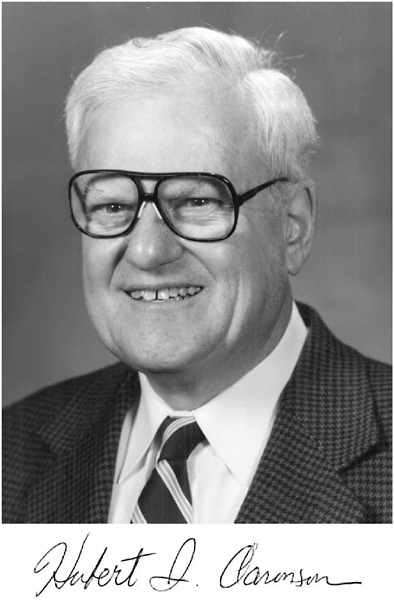HUBERT I . AARONSON
1924–2005
Elected in 1997
“For contributions to the understanding of diffusional phase transformation in commercial steels.”
BY JOHN P. HIRTH
HUBERT I. AARONSON, an international leader in the materials field, died December 13, 2005, after a lengthy illness. He continued working as R.F. Mehl Professor Emeritus at Carnegie Mellon University until the very end.
Born in New York City on July 10, 1924, Aaronson moved in 1936 to Jersey City, where he completed high school. Although his father and advisors discouraged him from going into engineering, his sister, Barbara, supported his goal. Hub envisioned great advances in engineering and he enrolled at Carnegie Institute of Technology (CIT), now Carnegie Mellon University, determined to become an engineer.
At the end of his second year, Hub was called into the service. He wanted to enter the U.S. Army Air Corps, and, helped by his comrades and others, he was able to do so. However, when he realized he was scheduled to enter bombardier school for B-24 Liberators, which had a poor survival rate, he showed up a week early at the B-17 training school instead. The bureaucracy absorbed this unprecedented change, and Hub went on to fly many B-17 missions during World War II.
When he resumed his studies after the war, he not only did very well in his classes, but also became editor of the campus newspaper. He completed his B.S., M.S., and Ph.D. in metallurgical engineering at CIT in 1948, 1954, and 1954, respectively.
His thesis advisor was the eminent metallurgist, R.F. Mehl. Hub remained at CIT as a research metallurgist until 1957, working with Mehl, G.M. Pound, and C. Wells. He then became a research scientist at Ford Scientific Laboratory (1958–1972), a professor at Michigan Technological University (1972–1979), R.F. Mehl Professor at Carnegie Mellon University (1979–1992), a scientist at the Naval Research Laboratory (1992–1996), and finally R.F. Mehl Professor Emeritus (1996–2005).
Hub was a giant in the field of phase transformation, to which he made many seminal contributions. One of his major contributions was defining and understanding the role of microstructure in phase transformations. In 1951, F.C. Frank had demonstrated the importance of ledges in the growth of crystals from vapor. Hub recognized the potential for similar effects in transformations in solids. In classic early work with K. Kinsman and M. Adams, he demonstrated that bainitic and other plate-shaped transformations proceeded by the motion of what he called “growth ledges.” Atomic-level ledges, or steps, which had dislocation content as well, relieved strains that would otherwise appear at interfaces between reactants and products. Hub called these defects structural ledges. In later work with a number of his students, he verified the nature of these defects by transmission electron microscopy and by computer simulations.
Hub engaged in a long, vigorous debate with J.W. Christian on the details of bainitic transformation. Hub’s view was that the diffusional composition change during the transformation accompanied the motion of ledges, while Jack Christian argued that the step structure (and accompanying shear) occurred first. Their views have been largely reconciled in the new millennium.
Hub also made significant contributions in alloy thermodynamics, the role of alloying elements in “hardenability” (retardation or enhancement of the rate of transformation) in steels, the mechanism of nucleation of new phases, interfacial energies, and the mechanism of massive transformation. His work had a substantial impact on the selection of materials for automobiles and Navy ships.
Hub was elected to the National Academy of Engineering in 1997, and he received many awards in recognition of his accom-
plishments. These included Fellow, R.F. Mehl Medalist, C.H. Mathewson Medalist, Educator Award, and Hume-Rothery Medalist from the Minerals, Metals, and Materials Society (TMS); Fellow and Albert Saveur Achievement Award from ASM International; and Honorary Member of the Japan Institute of Metals. He participated widely in international conferences as keynote speaker, conference organizer, and editor of conference proceedings.
Hub had a tremendous influence on his students and associates, and he was beloved by all of them. A stern taskmaster, but a friendly and helpful advisor and collaborator, his vision and optimism were inspiring, and his supportiveness was legendary. On three different occasions, his students organized symposia honoring him. He regularly held lavish dinner parties for his students, often reserving an entire restaurant for the occasion. He held similar events to entertain visiting scientists and speakers, often paying for them himself. He also funded portions of conferences he organized, particularly to help students to attend.
In a sense, his work was his hobby. He remained a bachelor throughout his life and worked long and unusual hours. Unless he had to attend a function or deliver a lecture, his day began at about 3 p.m. and ended around 5 a.m. Students and colleagues who wanted to see him had to fit in late afternoon appointments. Even Ford Scientific Laboratory accommodated his schedule and made special arrangements for him to work through the night.
He took vacations at posh resorts, often beaches, and lived the high life. He read assiduously, especially in military history. Indeed, this interest led him to work at the Naval Research Laboratory for four years after his retirement from Carnegie Mellon University.
Hub Aaronson was an internationally respected colleague, a valuable collaborator, a successful teacher, and a warm friend to many in the materials field. He will be missed, but his contributions will live on.
He is survived by his sister, Barbara A. McMurray, of Lafayette, Indiana.






